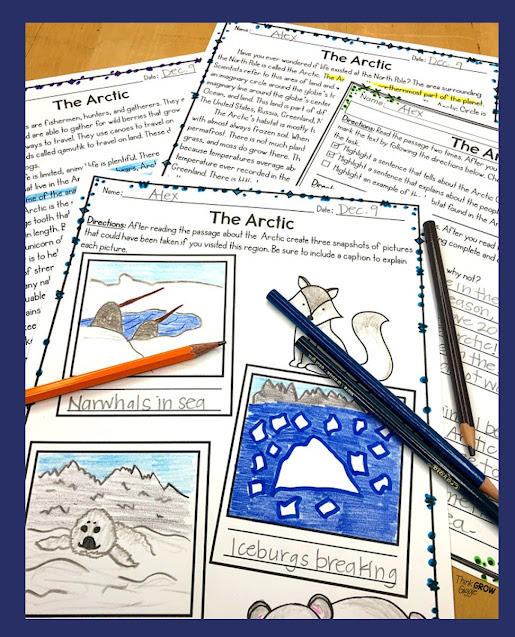Owl Moon by Jane Yolen
Grab the Owl Moon companion activity set HERE.
Brave
Irene by William Steig
The Five
Dog Night by Eileen Christelow
book that your students have not heard before, this is it! The Five Dog Night is the book that I look forward to reading each winter season. It tells the tale of two neighbors who help each other throughout the long and cold winter months. I love the themes of kindness and friendship that are woven throughout this story. Each time I read this book, the students always worry for the well-being of the characters, kicking off great empathy discussions in our classroom. I use this book to discuss character traits, making connections, themes, and most importantly, kindness. Grab a FREE kindness activity to use with this book
Grab the Five DogNight companion activity set HERE.
Snowflake
Bentley by Jacqueline Briggs Martin
Winter is
Here by Kevin Henkes
 This short
but sweet book is a great way to welcome winter into the classroom! It is
filled with vivid word choice, strong verbs, and figurative language, making it a great read-aloud for any classroom. Because the text is short, it naturally lends itself
for visualizing activities. Have students fold a blank piece of white paper
into fourths and number each box. Read aloud the book without showing students
the illustrations. Pause throughout the book frequently to allow students
enough time to create their own illustrations to go along with the words that
they hear. Reread the book again, this time sharing the book's pictures
with students so that they can again compare and contrast what they drew with
the illustrator's drawings. Grab a FREE follow-up figurative language visualizing activity to use with this book
This short
but sweet book is a great way to welcome winter into the classroom! It is
filled with vivid word choice, strong verbs, and figurative language, making it a great read-aloud for any classroom. Because the text is short, it naturally lends itself
for visualizing activities. Have students fold a blank piece of white paper
into fourths and number each box. Read aloud the book without showing students
the illustrations. Pause throughout the book frequently to allow students
enough time to create their own illustrations to go along with the words that
they hear. Reread the book again, this time sharing the book's pictures
with students so that they can again compare and contrast what they drew with
the illustrator's drawings. Grab a FREE follow-up figurative language visualizing activity to use with this book
BONUS Recommendations...
The Mitten Tree by Candace Christiansen
Snow Globe Family by Jane O'Connor
Snowflakes Fall by Patricia MacLachlan
Yetis are the Worst! by Alex Willan
The Stranger written by Chris Van Allsburg
On a drive one night, a family accidentally hits a man with their car. The family loads him up and brings him home to be checked by the family doctor. The students have to think about who the man is given all the things in the story that make the man “strange”. He cannot talk, animals flock to him, and he seems confused by very common and simple items. Through class discussion and context clues, see if you can infer who thisnameless man is! Grab some no-prep materials to go along with the story here!
You will love reading these related articles:
Grab highly engaging winter activities HERE.
*affiliate links: “Think Grow Giggle is a participant in the Amazon Services LLC Associates Program, an affiliate advertising program designed to provide a means for sites to earn advertising fees by advertising and linking to Amazon.” (source: Section 5)

































